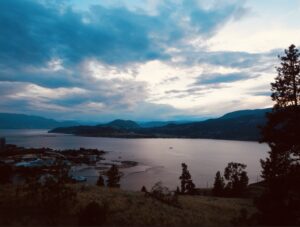Kelowna
September 19, 2023 By: Vic
Location: Kelowna

Prof. N. Fennema
HIST 3991: Environmental History
V. Pattenden
Sept 19, 2023
Kelowna
The city of Kelowna is situated upon the traditional territory of the Syilx/Okanagan People and its namesake originates from the Syilx/Okanagan word ki/ldwap?, meaning grizzly bear. (1) Kelowna is located between the Cascade and Columbia Mountain ranges on the Interior Plateau of BC with its core, downtown area being surrounded by Okanagan Lake. (2) The city of Kelowna has grown to become the biggest metropolitan area in the Central Okanagan and the third largest in British Columbia. Kelowna is a major tourism hotspot due to its desirable climate, modern recreational facilities, and abundance of parks, trails and beaches which offer a diversity of outdoor activities such as: biking, camping, hiking, rock climbing, boating, and water sports. Kelowna is also known for its wines, vineyards, and tree fruit industry, being the home of the company Sun Rype. In addition, Kelowna has more recently become a draw for movie production as a film locale.
Through a historical lens, Kelowna has changed drastically over time. The first inhabitants of Kelowna and the Okanagan Valley were the Indigenous Syilx/Okanagan people, who were thought to have settled around 9,000 years ago from a northern migration and continue to presently live throughout the Okanagan Valley. (3) Before European settlement and colonialism, the Syilx/Okanagan people subsisted in self-governing communities that lived in harmony with the natural world and adequately sustained their needs through fishing, hunting, gathering and trading with other bands. (4)
The first European contact to the Okanagan Valley came about in 1811 when David Stuart came to the area, however the first settlement did not materialize until 1859 when a Roman Catholic missionary by the name of Father Pandosy settled in the area and by the late 1800s a thriving tree fruit and agricultural industry was established. (3) During the same period and extending into the early 1900s, commissioners came and surveyed the valley and authorized the Syilx/Okanagan people to live on reserve lands which were located at Mission Creek and at the west end of Okanagan Lake. (4)
In 1905, with a population of around 600, the European settlement in Kelowna was officially incorporated and delegated control to its first mayor, Henry Raymer, and a street named in his honour is still present today. (3) Until 1925, Kelowna was completely dependent upon water vessels, such as steamboats and passenger ferries, for transportation over Okanagan Lake for travel, commute and trade, until the construction of the Okanagan Lake Bridge. (3)
According to the Westbank First Nations website, the Westbank Indian Band officially separated from the Okanagan Indian Band in 1963 and became independent. In addition, during the 1980s Canada granted the Westbank First Nations with official powers over land management and some agreements were settled over land used for Highway 97, which helped increase the Westbank First Nations land base. In 2004, the Westbank First Nations were granted self-governance through Bill C-11 and came into effect in 2005. (4) Another development in 2005 was the Kelowna Accord, which aimed to improve the lives of Indigenous people, and was signed by National Aboriginal Leaders and First Ministers. (3)
In 2008, the William R. Bennet Bridge was completed and allowed for more traffic and increased tourism through the accessibility of five-lanes. (3) Kelowna has many beautiful landmarks, including Okanagan Lake, Gallaghers Canyon and Mission Creek Falls. Kelowna boasts relatively mild winters and hot summer temperatures, although unfortunately these high summer temperatures combined with rapid development, questionable forestry practices, increasing mountain development, and increasing human negligence, make the area very vulnerable to wildfires which have been consistently increasing in size and intensity since 2003.
Kelowna is divided into many neighbourhoods which are delegated to several distinct districts including: Central City, Downtown, Midtown, Glenmore, Mission, Dilworth Mountain, and Rutland. The economic sector is diverse and divided into many different industries including agriculture, manufacturing, and construction, but it’s tourism that’s the driving factor, being estimated at bringing in over $1 billion annually. (3) Despite its beauty and seeming abundance, Kelowna has a major homelessness problem, which is especially prevalent in the downtown core and 21% percent of this homeless population identify as Indigenous. (5)
The city of Kelowna website outlines the city’s ongoing programs and initiatives that aim to protect the biologically diverse Central Okanagan Basin, including its water supplies and vulnerable areas, while acknowledging the growing concern of development pressures and intensive agricultural use.The City of Kelowna also has a specialized action plan regarding climate aimed specifically towards households and individuals, including things like energy consumption and climate preparedness, as well as, plans for long-term agricultural sustainability. (6) Despite all this effort, Kelowna has an extremely high carbon footprint due to transportation and has had the highest rate of car dependency in Canada since 2007. (3)
Okanagan Lake which resides through much of Kelowna and the Central Okanagan Valley also has another very unique and significant feature that has managed to garner national and even international appeal and curiosity: the Ogopogo or N’ha-a-itk. (2) This legendary creature is characterized as a huge and mysterious lake serpent that has been allegedly spotted on several occasions to the absolute delight of tourists.
Bibliography
1. “Our Community-About Kelowna-City Profile.” City of Kelowna. Accessed on Sept 15, 2023. https://www.kelowna.ca/our-community/about-kelowna/city-profile
2. “Okanagan Lake: Geography & Hydrology.” Turtle Bay Resort: Marina & Sea Plane Base. Accessed on Sept 17, 2023. https://www.kelownamarina.ca/okanagan-lake-info.php
3. “Kelowna.” Wikipedia. Accessed on Sept 15, 2023. https://en.m.wikipedia.org/wiki/Kelowna
4. “Our Community-About Westbank First Nations-History.” Westbank First Nations. Accessed on Sept 18, 2023. https://www.wfn.ca/our-community/community-profile/history.htm
5. “Kelowna.” The Homeless Hub. Accessed Sept 17, 2023. https://www.homelesshub.ca/community-profile/kelowna
6. “Our Community-Environment.” City of Kelowna. Accessed on Sept 15, 2023. https://www.kelowna.ca/our-community/environment/clean-water-volunteer-programs